The best collaborative writing tools enable teams to work together seamlessly, regardless of their physical location.
With an increasing number of organizations embracing remote work, these tools have become essential for improving productivity and maintaining clear communication among team members.
In this comprehensive guide, we’ll explore the top 11 best collaborative writing tools available in 2025.
Whether you’re a remote team seeking efficient document collaboration or a project manager aiming for streamlined workflows, our research-backed list has you covered.
Key Takeaways
- Collaborative writing tools significantly enhance team productivity.
- Many tools now integrate AI features for improved writing assistance.
- Choosing the right tool depends on specific user needs and project requirements.
Top 11 Picks for Best Collaborative Writing Tools
- Google Docs – Best for real-time collaboration
- Notion – Best for flexible workspaces
- Microsoft OneDrive – Best for integration with Office applications
- Slack – Best for team communication and file sharing
- Box – Best for content management and collaboration
- Asana – Best for project management and task tracking
- Trello – Best for visual project organization
- Airtable – Best for database-style project management
- ClickUp – Best for all-in-one task management
- Dropbox Paper – Best for collaborative document editing
- Wrike – Best for comprehensive project management
How We Evaluated Best Collaborative Writing Tools
The evaluation process for best collaborative writing tools focused on these key criteria:
- User Experience: We assessed the ease of use, interface design, and overall user satisfaction.
- Features: Tools were evaluated based on collaborative features such as real-time editing, commenting, and version control.
- Integrations: Compatibility with other software and platforms was crucial for seamless workflows.
- Pricing Structure: We compared each tool’s pricing to ensure they offer value for money.
- Customer Support: The availability of customer support options and resources was considered to aid users effectively.
This evaluation methodology included user testing, expert consultations, and thorough online research to ensure accuracy and relevance.
Best Collaborative Writing Tools Comparison Table
| Software | Best For | Key Features | Pricing | Free Plan | Platforms Available |
|---|---|---|---|---|---|
| Google Docs | Real-time collaboration | Real-time editing, commenting, templates | Free (with Google account) | Yes | Web, iOS, Android |
| Notion | Flexible workspaces | Notes, databases, Kanban boards | Free, €9.50/user/mo (billed annually) | Yes | Web, Mac, Windows, iOS, Android |
| Microsoft OneDrive | Integration with Office applications | Cloud storage, file sharing | Free, $9,99/user/mo (billed annually) | Yes | Web, Mac, Windows, iOS, Android |
| Slack | Team communication | Channels, direct messaging, file sharing | Free, €4.13/user/mo (billed annually) | Yes | Web, Mac, Windows, iOS, Android |
| Box | Content management | Secure data storage, AI insights, E-signatures | Free, $15/user/mo (billed annually) | Yes | Web, iOS, Android |
| Asana | Project management | Task assignments, timelines, reporting | Free, $10.99/user/mo (billed annually) | Yes | Web, Mac, Windows, iOS, Android |
| Trello | Visual project organization | Boards, lists, cards | Free, $10/user/mo (billed annually) | Yes | Web, Mac, Windows, iOS, Android |
| Airtable | Database-style project management | Grid, calendar, gallery views | Free, $20/user/mo (billed annually) | Yes | Web, Mac, Windows, iOS, Android |
| ClickUp | All-in-one task management | Task lists, goal tracking, time tracking | Free, $7/user/mo (billed annually) | Yes | Web, Mac, Windows, iOS, Android |
| Dropbox Paper | Collaborative document editing | Document sharing, task management | Free, $15/user/mo (billed annually) | Yes | Web, iOS, Android |
| Wrike | Comprehensive project management | Gantt charts, time tracking, reporting | Free, $10/user/mo (billed annually) | Yes | Web, Mac, Windows, iOS, Android |
1. Google Docs
Best for real-time collaboration
Google Docs is a widely used tool for collaborative writing, offering real-time editing and commenting features that make teamwork effortless. Its cloud-based nature allows users to access documents from anywhere, making it ideal for remote teams.
With robust features like version history and easy sharing options, Google Docs caters to both casual users and professionals.
Pros
- User-friendly interface
- Excellent real-time collaboration
- Free with a Google account
Cons
- Limited offline capabilities
- Less advanced formatting options compared to desktop alternatives
Key Features
- Real-time collaboration: Multiple users can edit documents simultaneously.
- Commenting: Users can leave feedback directly on the document.
- Templates: Offers a wide range of document templates for various purposes.
Pricing
Google Docs is available for free with a Google account. For additional features, users can opt for Google Workspace plans starting at $7,90/user/mo. Visit the pricing page for details.
2. Notion
Best for flexible workspaces
Notion combines note-taking, document collaboration, and project management into one flexible workspace. It’s highly customizable, allowing teams to create tailored workflows. Notion’s versatility makes it suitable for various use cases, from project management to personal note-taking.

Pros
- Highly customizable interface
- Integrates notes with databases and tasks
- Supports various content types (text, images, tables)
Cons
- Can be overwhelming for new users
- Advanced features may require a learning curve
Key Features
- Workspace customization: Users can create unique layouts that suit their workflow.
- Database functionality: Allows for structured data management alongside notes.
- Cross-platform availability: Accessible on web, desktop, and mobile devices.
Pricing
Notion offers a free plan, with paid plans starting at €9.50/user/mo when billed annually. For more details, check the pricing page.
3. Microsoft OneDrive
Best for integration with Office applications
Microsoft OneDrive seamlessly integrates with Microsoft’s suite of Office applications, making it a powerful tool for businesses already using these services.
OneDrive allows users to store, share, and collaborate on documents in real-time.

Pros
- Strong integration with Microsoft Office
- Reliable cloud storage with high security
- User-friendly interface
Cons
- Limited functionality without Office subscriptions
- May experience slower performance with large files
Key Features
- File sharing: Easily share documents with colleagues.
- Real-time collaboration: Multiple users can edit documents at once.
- Version history: Keep track of changes made to documents.
Pricing
Microsoft OneDrive offers a free tier with 5GB of storage, while paid plans start at $9,99/user/mo (billed annually). More information can be found on the pricing page.
4. Slack
Best for team communication
Slack enhances team communication by providing organized channels for discussions and file sharing. While primarily a messaging platform, it also offers collaborative document editing features, making it a versatile tool for teams.
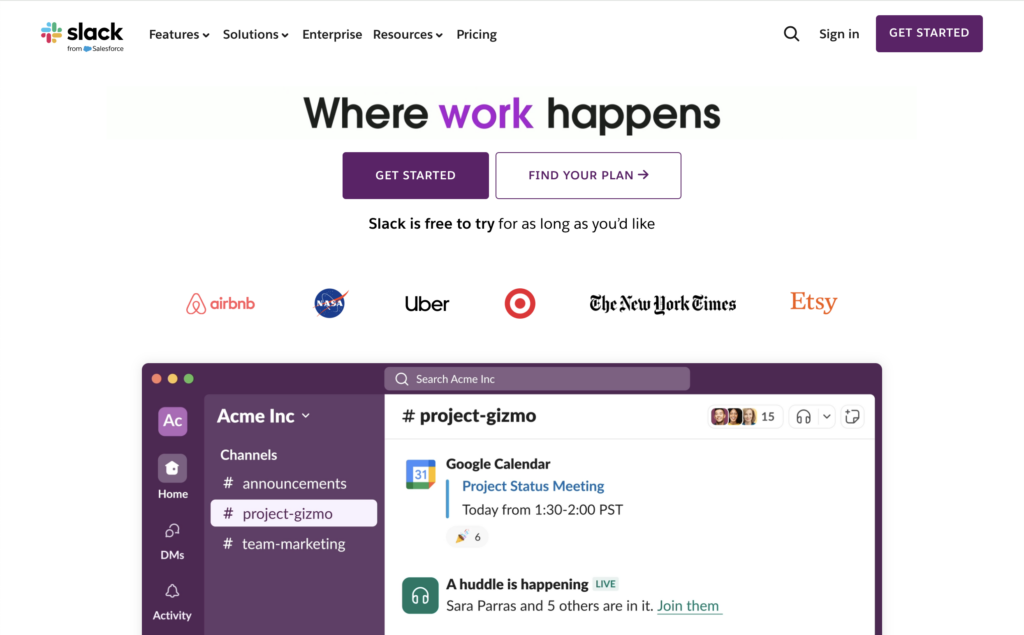
Pros
- Organized communication channels
- Integrates with various apps for seamless workflows
- Easy file sharing and collaboration
Cons
- Can become cluttered with too many channels
- Limited storage on free plan
Key Features
- Channels: Organize conversations by topic or project.
- Direct messaging: Communicate privately with team members.
- Integration capabilities: Connect with other productivity tools for streamlined workflows.
Pricing
Slack offers a free plan with limited features, while paid plans start at €4.13/user/mo (billed annually). For more details, visit the pricing page.
5. Box
Best for content management and collaboration
Box is an intelligent content management solution that facilitates secure collaboration and workflow automation. Additionally, it offers a robust document management system that organizes, manages, and governs data to ensure regulatory compliance.
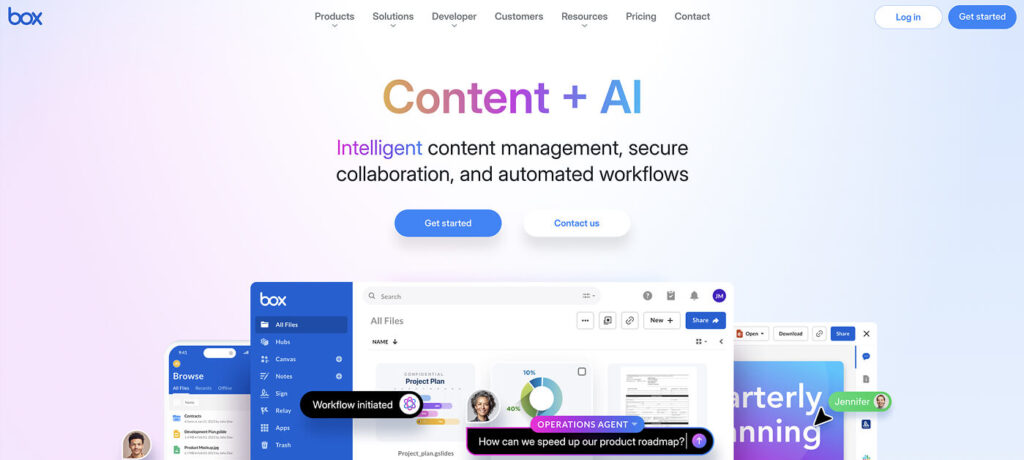
Pros
- Easy and intuitive user interface
- Secure file sharing
- Version control
Cons
- Storage limitations
- Slow performance
Key Features
- Secure data storage: Organize and access files from multiple devices
- AI insights: Get actionable AI insights from unstructured data and content
- E-signatures: AI-based signature workflows to sign, approve, and track documents
Pricing
Box has a free version for individuals, while the Business starter plan begins from $15 per user per month. For more information, check the pricing page.
6. Asana
Best for project management
Asana is a robust project management tool that helps teams organize tasks, track progress, and collaborate effectively. Its user-friendly interface allows for easy navigation and task assignment.

Pros
- Visual project tracking with timelines
- Task assignments and due dates
- Integration with various productivity tools
Cons
- Can become complex for larger teams
- Advanced features behind paywall
Key Features
- Task management: Assign tasks and set deadlines.
- Project timelines: Visualize project progress with Gantt charts.
- Reporting tools: Generate reports to track team performance.
Pricing
Asana offers a free version with essential features, while premium plans start at $10.99/user/mo (billed annually). Check the pricing page for more details.
7. Trello
Best for visual project organization
Trello uses a visual Kanban board system that makes project management intuitive. Users can create boards for different projects and organize tasks with cards, making it ideal for teams that prefer a visual approach.
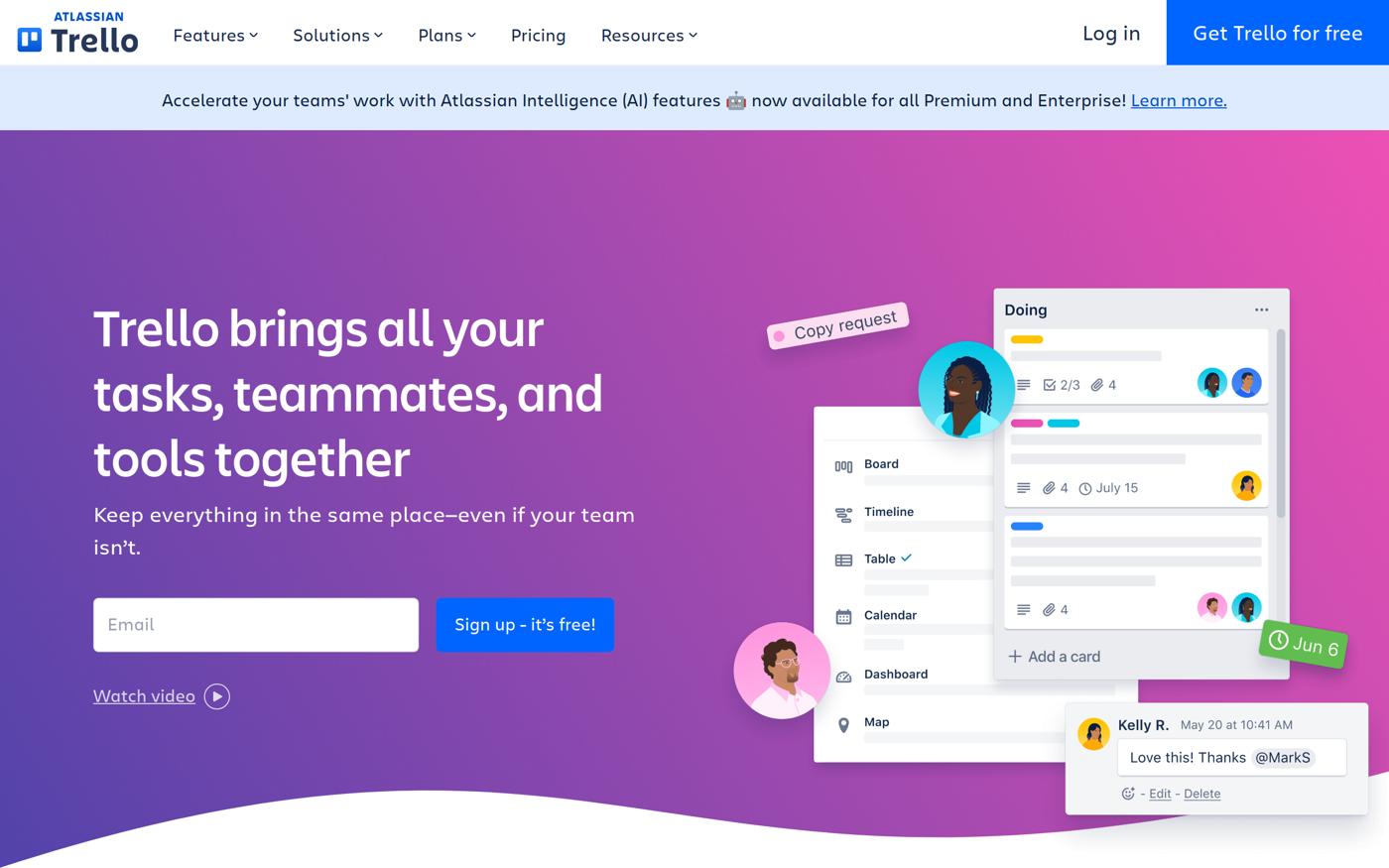
Pros
- Simple and intuitive interface
- Flexible organization with boards and cards
- Great for tracking progress visually
Cons
- Limited features in the free version
- Can be less effective for complex projects
Key Features
- Kanban boards: Organize tasks visually with drag-and-drop functionality.
- Labels and due dates: Easily prioritize tasks and set deadlines.
- Integration with other tools: Connect with apps like Slack and Google Drive.
Pricing
Trello is free for basic use, with premium plans starting at $10/user/mo (billed annually). For more information, visit the pricing page.
8. Airtable
Best for database-style project management
Airtable combines the functionalities of a spreadsheet with a database, allowing users to manage projects in a flexible manner. Its visual interface makes it easy to organize and collaborate on data-driven tasks.
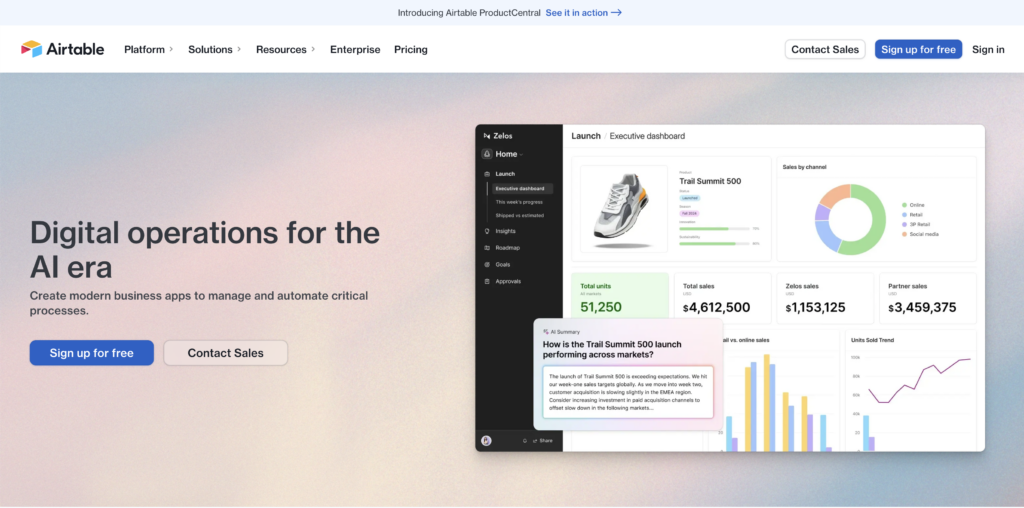
Pros
- Combines spreadsheet and database features
- Highly customizable views (Grid, Calendar, Gallery)
- Excellent for data organization
Cons
- Can be too complex for simple tasks
- Advanced features may require a learning curve
Key Features
- Customizable fields: Tailor data entries to suit project needs.
- Templates: Use pre-designed templates to get started quickly.
- Collaboration features: Share bases and collaborate in real time.
Pricing
Airtable offers a free plan, with paid plans starting at $20/user/mo (billed annually). More information can be found on the pricing page.
9. ClickUp
Best for all-in-one task management
ClickUp is an all-in-one project management tool that combines tasks, docs, goals, and chat in one platform. It’s designed to replace multiple productivity tools, making it suitable for teams looking for an integrated solution.
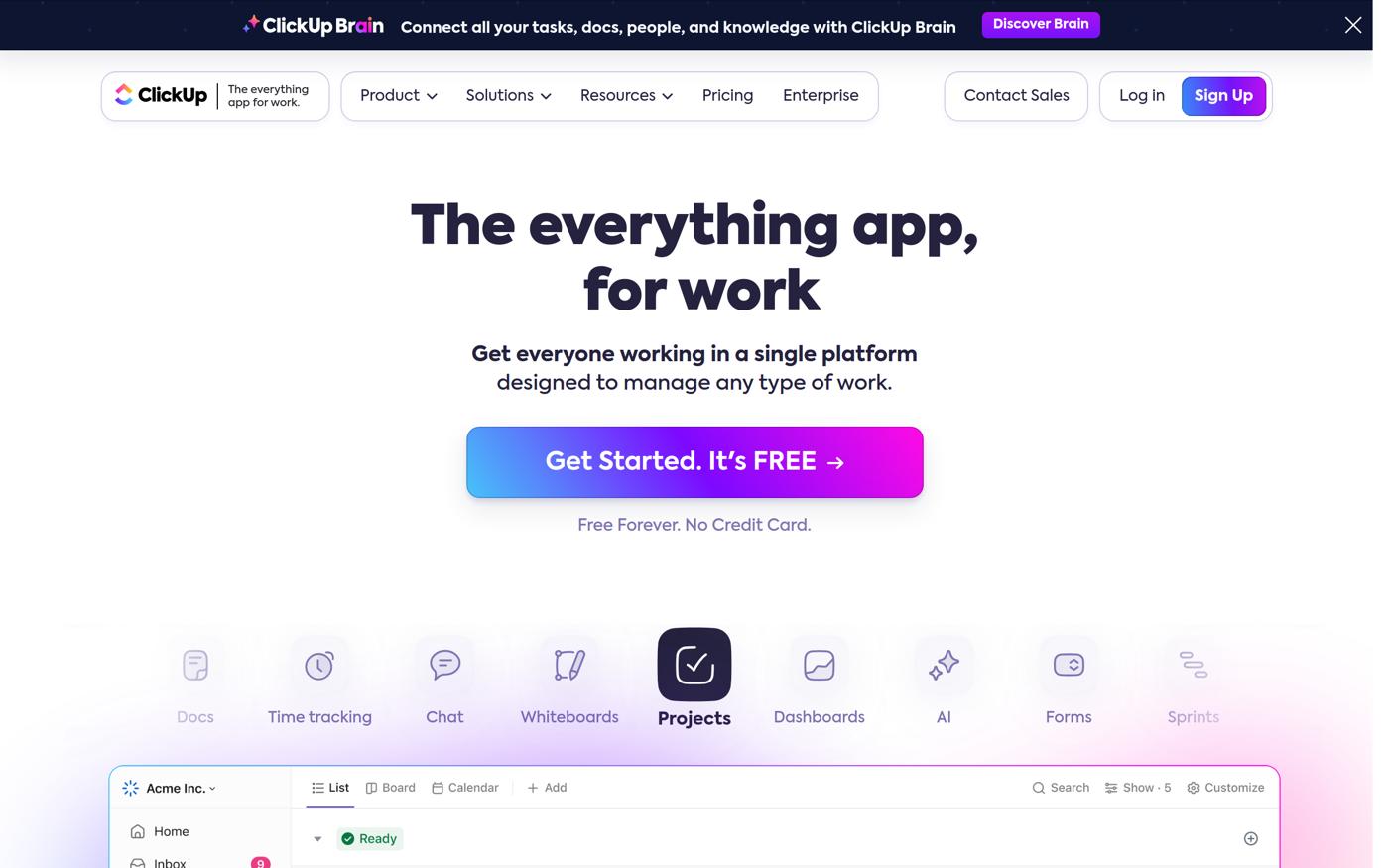
Pros
- Comprehensive functionality covering all project aspects
- Highly customizable tasks and views
- Integration with numerous apps
Cons
- Can be overwhelming for new users
- Some features may be too advanced for smaller teams
Key Features
- Task management: Create, assign, and track tasks easily.
- Goals tracking: Set and monitor team or individual goals.
- Time tracking: Keep track of time spent on tasks for better management.
Pricing
ClickUp offers a free plan, with premium plans starting at $7/user/mo (billed annually). Visit the pricing page for more details.
10. Dropbox Paper
Best for collaborative document editing
Dropbox Paper is a collaborative document-editing tool that integrates with Dropbox for seamless file management. It allows teams to create, edit, and comment on documents in real time.
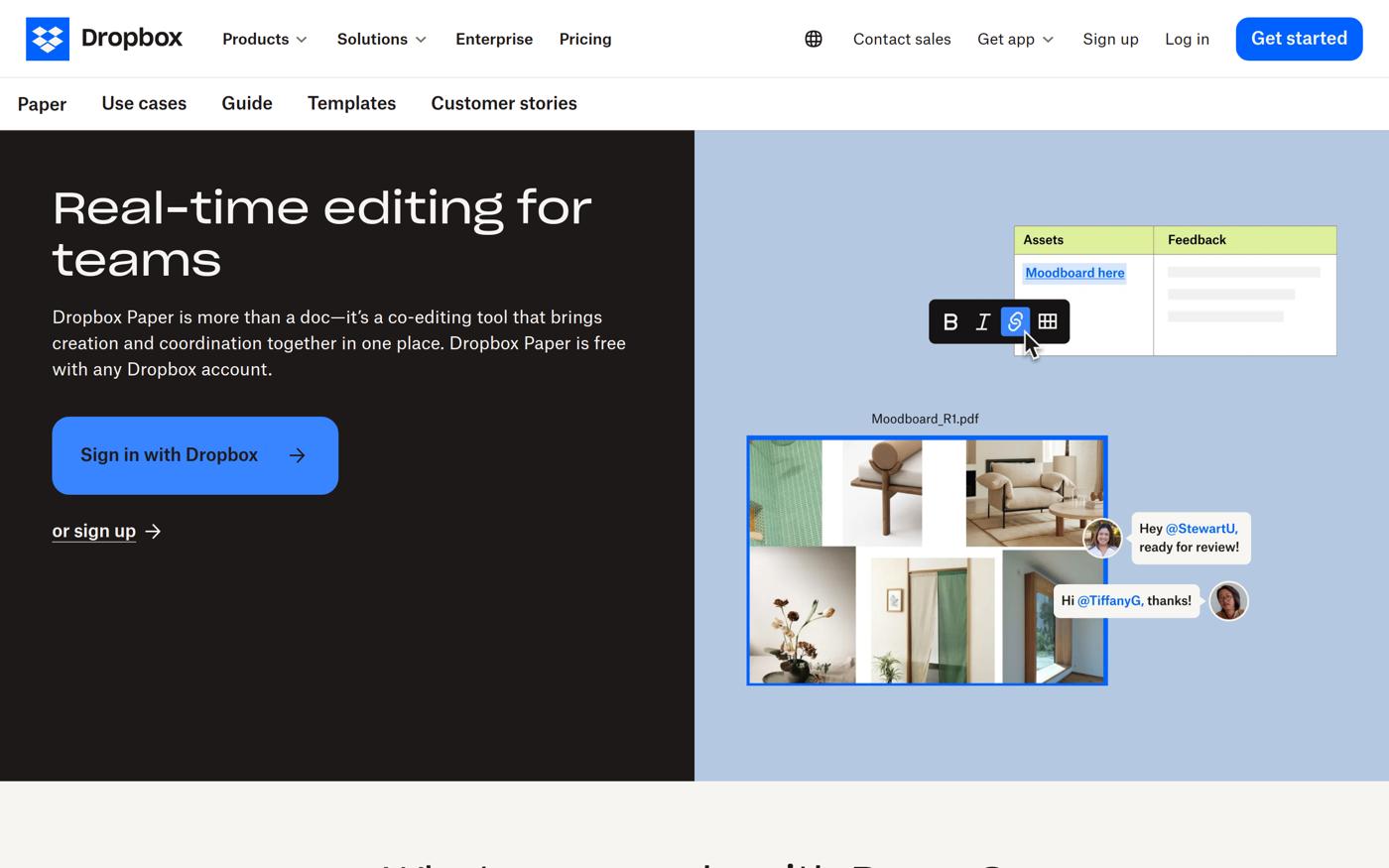
Pros
- Simple and clean interface
- Integrates with Dropbox for easy file access
- Supports rich media and task lists
Cons
- Limited features compared to more established tools
- May not be suitable for larger teams
Key Features
- Document collaboration: Edit documents together in real time.
- Task management: Create to-do lists within documents.
- Integration with Dropbox: Access files easily from your Dropbox account.
Pricing
Dropbox Paper is free for all users with a Dropbox account. For more details, check the pricing page.
11. Wrike
Best for comprehensive project management
Wrike provides robust project management features, including Gantt charts, time tracking, and reporting tools. It’s designed for teams that need comprehensive project oversight and collaboration.

Pros
- Extensive project management features
- In-depth reporting capabilities
- Customizable workflows
Cons
- Can be complex for new users
- Higher pricing compared to competitors
Key Features
- Gantt charts: Visualize project timelines and dependencies.
- Time tracking: Monitor time spent on tasks for better resource management.
- Collaboration tools: Facilitate teamwork with comments and shared files.
Pricing
Wrike offers a free version with basic features, while premium plans start at $10/user/mo (billed annually). Visit the pricing page for more details.
How to Choose the Right Best Collaborative Writing Tool for Your Needs
Selecting the ideal best collaborative writing tool depends on your specific requirements and use case. Consider these crucial factors:
- Team Size: Larger teams may require tools with advanced features for managing tasks and communication.
- Integration Needs: Ensure the tool you choose integrates well with your existing software.
- Budget Constraints: Evaluate the pricing plans to find a tool that fits your budget while meeting your needs.
- Ease of Use: A user-friendly interface can enhance team adoption and productivity.
Common misconceptions about collaborative writing tools often revolve around their complexity or cost. However, many modern tools offer free versions with essential features, making them accessible for teams of all sizes.
Emerging Trends in Best Collaborative Writing Tools
One notable trend is the integration of AI features that assist users in crafting better content, streamlining workflows, and reducing the time spent on editing.
According to recent industry reports, tools that leverage AI for writing support are gaining popularity, with many users seeking more efficient ways to collaborate and produce content.
Additionally, as hybrid work models become more prevalent, organizations are prioritizing tools that facilitate seamless communication and shared workflows. This shift is driving the demand for versatile collaborative writing tools that can adapt to different team structures and project needs.
Making the Right Choice
Choosing the right collaborative writing tool is crucial for enhancing productivity and fostering effective teamwork. Whether you prioritize real-time collaboration, project management features, or integration capabilities, there’s a tool on this list that can meet your needs.
We encourage you to evaluate your specific requirements and explore the top picks outlined in this guide to find the ideal solution for your team.
Frequently Asked Questions
Most common questions asked when choosing collaborative writing tools.
What are the best collaborative writing tools for teams in 2025?
The best collaborative writing tools for 2025 include Google Docs, Notion, Microsoft OneDrive, Slack, Asana, Trello, Airtable, ClickUp, Dropbox Paper, and Wrike.
How do collaborative writing tools enhance productivity?
Collaborative writing tools enhance productivity by enabling real-time collaboration, improving communication, and streamlining project management processes.
Are there free collaborative writing tools available?
Yes, many collaborative writing tools offer free versions with essential features, such as Google Docs, Trello, and ClickUp.
What features should I look for in a collaborative writing tool?
Key features to look for include real-time editing, commenting capabilities, integration with other tools, and user-friendly interfaces.
What are the emerging trends in collaborative writing tools?
Emerging trends include the integration of AI features for enhanced writing assistance and the prioritization of tools that support hybrid work environments.
